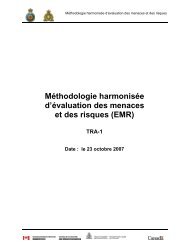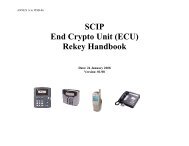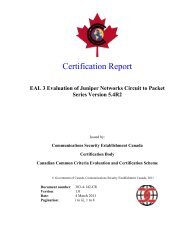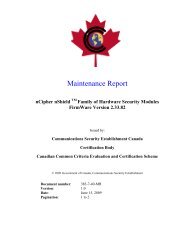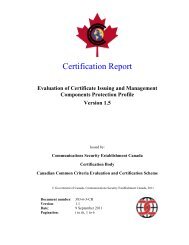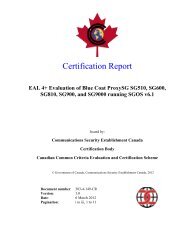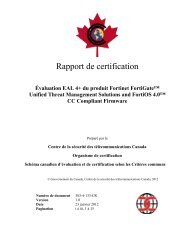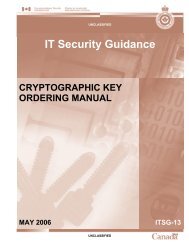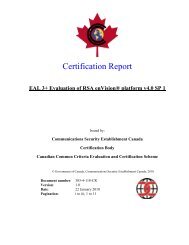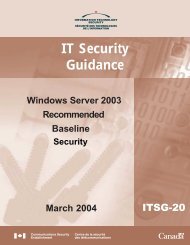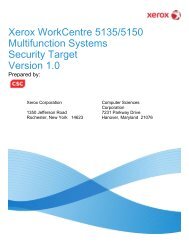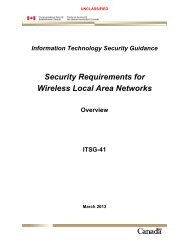Conseils sur l'utilisation du protocole TLS - Centre de la sécurité des ...
Conseils sur l'utilisation du protocole TLS - Centre de la sécurité des ...
Conseils sur l'utilisation du protocole TLS - Centre de la sécurité des ...
You also want an ePaper? Increase the reach of your titles
YUMPU automatically turns print PDFs into web optimized ePapers that Google loves.
November 2008 ITSB-60 novembre 2008<br />
The Advanced Encryption Standard (AES) is<br />
an approved block cipher with 128, 192 or<br />
256 bits of security.<br />
http://csrc.nist.gov/publications/fips/fips197/<br />
fips-197.pdf<br />
SKIPJACK and KEA Algorithm<br />
Specifications Version 2.0<br />
This document is the specification for the<br />
SKIPJACK encryption algorithm.<br />
http://csrc.nist.gov/encryption/skipjack/skipj<br />
ack.pdf<br />
IETF RFC 2144<br />
This standard specifies the CAST5 (also<br />
called CAST-128) encryption algorithm.<br />
http://tools.ietf.org/html/rfc2144<br />
Random Bit Generation<br />
The following reference contains the newest<br />
and preferred methods to generate random bits.<br />
NIST Special Publication 800-90<br />
This publication specifies how to generate<br />
random bits by using <strong>de</strong>terministic methods<br />
based on hash functions, block ciphers, or<br />
number theoretic problems.<br />
http://csrc.nist.gov/publications/nistpubs/800<br />
-90/SP800-90revised_March2007.pdf<br />
The following four references contain the<br />
legacy <strong>de</strong>terministic random bit generators<br />
(DRBG) which are currently approved.<br />
NIST-Recommen<strong>de</strong>d Random Number<br />
Generator Based on ANSI X9.31<br />
Appendix A.2.4 Using the 3-Key Triple<br />
DES and AES Algorithms<br />
This document specifies how to use 3-key<br />
Triple DES and AES instead of DES based<br />
on ANS X9.31.<br />
http://csrc.nist.gov/groups/STM/cavp/docum<br />
DES.<br />
FIPS 197<br />
La norme AES (Advanced Encryption Standard)<br />
est un chiffrement par bloc approuvé avec 128,<br />
192 ou 256 bits <strong>de</strong> sécurité.<br />
http://csrc.nist.gov/publications/fips/fips197/fips-<br />
197.pdf<br />
Spécification <strong>de</strong>s algorithmes SKIPJACK et<br />
KEA, Version 2.0<br />
Ce document constitue <strong>la</strong> spécification pour<br />
l’algorithme <strong>de</strong> chiffrement SKIPJACK.<br />
http://csrc.nist.gov/encryption/skipjack/skipjack.p<br />
df<br />
IETF RFC 2144<br />
Cette norme précise l’algorithme <strong>de</strong> chiffrement<br />
CAST5 (aussi nommée CAST-128).<br />
http://tools.ietf.org/html/rfc2144<br />
Génération <strong>de</strong> bits aléatoires<br />
La référence suivante traite <strong>de</strong>s nouvelles métho<strong>de</strong>s<br />
préférées pour générer <strong>de</strong>s bits aléatoires.<br />
Publication spéciale 800-90 <strong>du</strong> NIST<br />
Cette publication spéciale précise comment<br />
générer <strong>de</strong>s bits aléatoires à l’ai<strong>de</strong> <strong>de</strong> métho<strong>de</strong>s<br />
déterministes fondées <strong>sur</strong> <strong>de</strong>s fonctions <strong>de</strong><br />
hachage, le chiffrement par blocs ou <strong>de</strong>s<br />
problèmes théoriques liés aux nombres.<br />
http://csrc.nist.gov/publications/nistpubs/800-<br />
90/SP800-90revised_March2007.pdf<br />
Les quatre références suivantes traitent <strong>de</strong>s anciens<br />
générateurs <strong>de</strong> bits aléatoires déterministes,<br />
actuellement approuvés.<br />
Générateur <strong>de</strong> nombres aléatoires<br />
recommandé par le NIST selon l’ANSI X9.31,<br />
appendice A.2.4, au moyen <strong>de</strong>s algorithmes<br />
AES et Triple DES à 3 clés<br />
10



